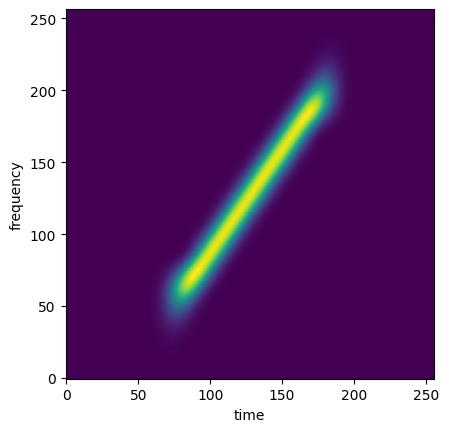mcsm-benchs: Benchmarking methods for signal detection
In this notebook, we show how to benchmark signal detection methods using mcsm-benchs. We begin by importing a series of useful libraries.
[21]:
import numpy as np
from numpy import pi as pi
# import pandas as pd
from matplotlib import pyplot as plt
from mcsm_benchs.Benchmark import Benchmark
from mcsm_benchs.ResultsInterpreter import ResultsInterpreter
from mcsm_benchs.SignalBank import SignalBank
from utils import get_stft
Creating a signal dictionary for the benchmark
We then create a dictionary of signals to detect. As an example, let’s use one signal composed of a linear chirp that spans half of the signal length using the SignalBank class.
[22]:
N = 256 # Signal length in time samples.
sb = SignalBank(N=N,Nsub=N//2)
signal_1 = sb.signal_linear_chirp()
# Let's see the signal spectrogram:
stft = get_stft(signal_1)
spectrogram = np.abs(stft)**2
plt.imshow(spectrogram, origin='lower')
plt.xlabel('time'); plt.ylabel('frequency')
# Finally, create the dictionary of signals for the benchmark
signals = {'signal_1':signal_1}

Creating a dictionary of methods to compare
Before defining the benchmark, let’s create a dictionary of methods. Our first signal detection method is based on a matched filter. It will search for a template signal within the signal we probe, and indicate if the correlation between both template and probing signal surpasses a certain threshold.
[23]:
from scipy.signal import convolve
def matched_filter(signal, template):
"""
Applies a matched filter to a signal using a given template.
"""
matched_filter_kernel = template[::-1]
# Perform convolution
output = convolve(signal, matched_filter_kernel, mode='same')
return output
def detection_method_1(signal):
"""
Signal detection based on matching filter.
"""
output = matched_filter(signal,template=signal_1)
output /= np.max(output)
if len(output[output>0.9])==1:
return True
else:
return False
# Example usage:
signal = np.random.randn(len(signal_1)) + signal_1 # Noisy signal! Should output "True" most of the times.
filtered_signal = matched_filter(signal, signal_1)
filtered_signal /= np.max(filtered_signal)
print(detection_method_1(signal))
True
The second signal detection method is a detection test. The null hypothesis is that the probed signal is composed of only white Gaussian noise, whereas the alternative hypothesis is that the probed signal is actually a mixture of signal and white Gaussian noise.
The test is based on considering that the distribution of each pixel of the spectrogram of white Gaussian noise is distributed as \(\chi^2\) with two degrees of freedom. We then evaluate if any of ten random positions of the spectogram are above a threshold selected to have a false alarm rate of 5%.
[24]:
import scipy.stats as ss
def detection_method_2(signal):
stft = get_stft(signal,scaling='psd')
std_estim = np.median(np.abs(np.real(stft)))/0.6745
num = ss.chi2.isf(0.05/10,2)
thr = num*std_estim**2
aux = np.abs(stft.flatten())**2
positions = np.random.randint(0,stft.size,size=10)
if np.any( aux[positions] > thr):
return True
else:
return False
# det = 0
# for i in range(500):
# noise = np.random.randn(32)
# det += detection_method_2(noise)
# det/500
Finally, we create a dictionary of methods to compare, instantiate a benchmark object and run the comparisons.
[25]:
methods = {'detection_method_1':detection_method_1,'detection_method_2':detection_method_2}
benchmark = Benchmark(task='detection',
methods=methods,
# parameters=parameters,
signal_ids=signals,
SNRin=[-10,-5,0,5],
repetitions=30,
N = N)
[26]:
benchmark.run()
Running benchmark...
- Signal signal_1
100%|██████████| 4/4 [00:00<00:00, 14.54it/s]
The test has finished.
[26]:
{'perf_metric': {'signal_1': {-10: {'detection_method_1': {'((), {})': [True,
True,
True,
True,
True,
True,
True,
True,
True,
True,
True,
True,
True,
True,
True,
True,
True,
True,
True,
True,
True,
False,
True,
False,
True,
True,
False,
True,
True,
True]},
'detection_method_2': {'((), {})': [False,
False,
False,
False,
False,
False,
False,
False,
True,
False,
False,
False,
False,
False,
True,
False,
False,
False,
False,
False,
False,
False,
False,
False,
False,
False,
True,
False,
False,
False]}},
-5: {'detection_method_1': {'((), {})': [True,
True,
True,
True,
True,
True,
True,
True,
True,
True,
True,
True,
True,
True,
True,
True,
True,
True,
True,
True,
True,
True,
True,
True,
True,
True,
True,
True,
True,
True]},
'detection_method_2': {'((), {})': [False,
False,
False,
False,
False,
False,
True,
False,
True,
False,
True,
True,
False,
False,
False,
False,
False,
False,
True,
False,
False,
False,
False,
True,
False,
False,
False,
False,
False,
False]}},
0: {'detection_method_1': {'((), {})': [True,
True,
True,
True,
True,
True,
True,
True,
True,
True,
True,
True,
True,
True,
True,
True,
True,
True,
True,
True,
True,
True,
True,
True,
True,
True,
True,
True,
True,
True]},
'detection_method_2': {'((), {})': [True,
False,
True,
True,
False,
False,
True,
True,
False,
True,
True,
True,
False,
False,
False,
False,
True,
True,
False,
False,
True,
False,
False,
True,
False,
False,
True,
True,
True,
False]}},
5: {'detection_method_1': {'((), {})': [True,
True,
True,
True,
True,
True,
True,
True,
True,
True,
True,
True,
True,
True,
True,
True,
True,
True,
True,
True,
True,
True,
True,
True,
True,
True,
True,
True,
True,
True]},
'detection_method_2': {'((), {})': [True,
False,
False,
True,
True,
True,
True,
False,
False,
True,
True,
False,
True,
True,
False,
True,
False,
False,
True,
False,
True,
True,
True,
True,
True,
True,
True,
False,
False,
False]}}}}}
Showcasing results
Once results are available we can display summary plots using the functionality of the ResultsInterpreter class.
[27]:
# Summary interactive plots with Plotly and a report.
from plotly.offline import iplot
import plotly.io as pio
pio.renderers.default = "plotly_mimetype+notebook"
interpreter = ResultsInterpreter(benchmark)
figs = interpreter.get_summary_plotlys(bars=True,ylabel='Prob. of Detection')
for fig in figs:
iplot(fig)